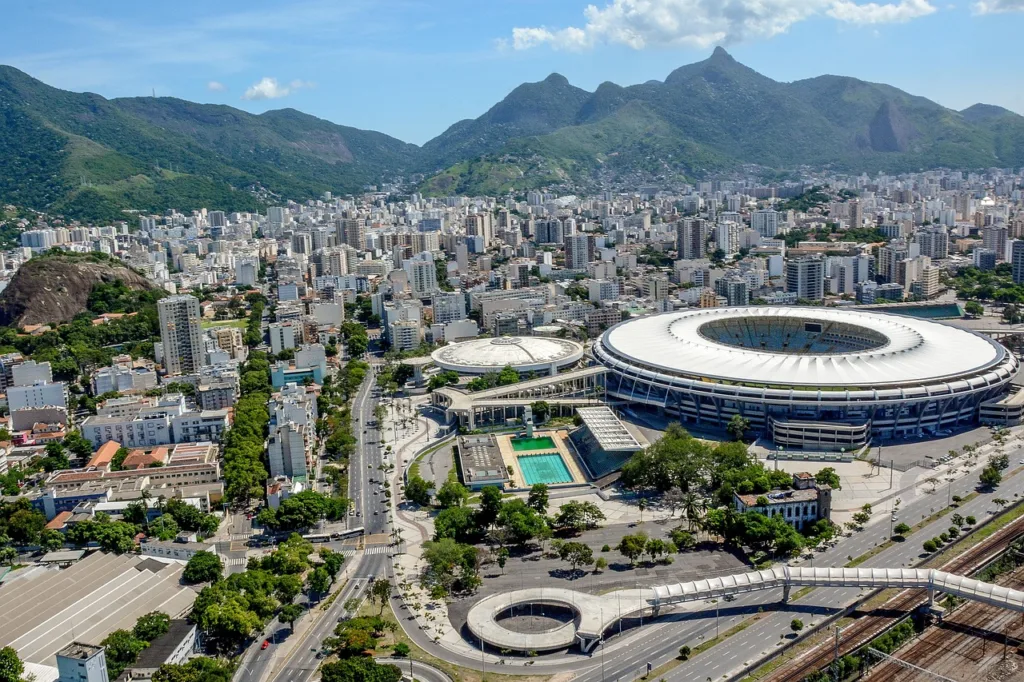Historical Context of Brazil’s Language
The historical backdrop of Brazil’s linguistic environment begins with the arrival of Portuguese explorers in the early 1500s. This pivotal moment was part of a broader wave of European exploration and colonization that sought to claim new territories and resources in the New World. The Treaty of Tordesillas, enacted in 1494, was crucial in this context, as it effectively divided the newly discovered lands outside Europe between Spain and Portugal. According to the terms set forth in this treaty, the western portion of South America was designated for Spanish colonization, while the eastern portion remained under Portuguese jurisdiction.
The implications of this division were monumental for Brazil. The Portuguese established their presence along the Brazilian coastline and began to claim land, setting the stage for extensive colonization. This process involved not only the imposition of Portuguese governance but also the introduction of the culture, religion, and language of Portugal to the indigenous populations. Over the course of the 16th century, the Portuguese Crown sent various expeditions of settlers and missionaries, further entrenching the use of the Portuguese language.
As a result, Portuguese rapidly began to dominate the linguistic landscape of Brazil, outperforming indigenous languages and the relatively limited presence of Spanish, which was largely confined to provinces that fell under Spanish rule. The early colonial period was characterized by not only the establishment of settlements but also the interaction and intermingling between Portuguese settlers and native tribes. This interaction facilitated the spread and adaptation of the language, leading to the creation of a unique Brazilian Portuguese dialect that incorporated elements from indigenous languages and African languages brought by enslaved people.
Thus, the combination of colonial policies, cultural exchanges, and the demarcation established by the Treaty of Tordesillas laid the foundation for Portuguese to become the prevailing language in Brazil, profoundly influencing the nation’s identity and linguistic heritage to this day.
Colonial Impact on Language Development
The Portuguese colonization of Brazil, commencing in the early 16th century, significantly influenced the nation’s linguistic landscape. As Portuguese settlers established their presence, they encountered a multitude of indigenous languages, with over 200 distinct languages spoken at the time. This interaction catalyzed a process of linguistic adaptation; many terms from indigenous tongues were integrated into Portuguese, enriching its lexicon and creating a unique form of communication that reflected the diverse cultural milieu of Brazil. The infusion of native words into the Portuguese language is evident in various aspects of Brazilian life, from flora and fauna to cultural practices.
Furthermore, the transatlantic slave trade introduced a substantial number of African languages to Brazil. Enslaved Africans, originating from diverse ethnic backgrounds, brought their languages, which further influenced the development of Brazilian Portuguese. This interaction not only affected vocabulary but also contributed to the phonetics and rhythm of the language. The emergence of Creole languages and dialects in specific regions of Brazil exemplifies this syncretism, showcasing how different linguistic elements blended to form a regional speech that was distinct yet rooted in Portuguese.
In addition to the indigenous and African linguistic influences, subsequent waves of immigration introduced further languages into Brazil’s linguistic tapestry. Immigrants from Italy, Germany, Japan, and other countries brought their languages, which interacted with Portuguese, leading to localized dialects. This ongoing evolution underscores the dynamic nature of Brazilian Portuguese, shaped in part by its colonial history. The language’s development is a testament to the complex interplay of colonization, cultural exchange, and social transformation, resulting in a rich, multifaceted linguistic heritage that continues to evolve today.
The Role of National Identity
The intricate relationship between language and national identity is a defining characteristic of Brazil, where Portuguese, rather than Spanish, serves as the predominant means of communication. The adoption of Portuguese as the official language has played a significant role in shaping the country’s national identity, fostering a sense of unity and cultural pride among its citizens. With a history colored by colonialism and the need for distinctiveness in a region primarily inhabited by Spanish-speaking nations, the promotion of Portuguese facilitated the emergence of a unique Brazilian identity.
In the wake of independence from Portuguese colonial rule in the 19th century, the decision to retain Portuguese as the national language was a strategic move that underscored the desire to distinguish Brazil from its neighbors. This linguistic choice became a vital aspect of national cohesion, enabling the diverse population of Brazil to communicate effectively while forging a collective identity. The language’s association with Brazil’s rich cultural heritage—rooted in literature, music, and regional expressions—has reinforced national pride, thereby solidifying its status beyond mere communication.
Language policy and education have also played instrumental roles in maintaining Portuguese as the national language. The Brazilian government has implemented various measures to promote the language across all levels of education, ensuring its continued relevance and use among citizens. By prioritizing Portuguese in schools and official discourse, Brazil has successfully instilled a sense of linguistic loyalty that transcends regional dialects and variations. This commitment to Portuguese not only promotes effective communication but also nurtures an enduring bond among Brazilians, all of whom share the common thread of language as a central pillar of identity.
Educational Policies and Language Promotion
The role of Brazil’s educational system in promoting the Portuguese language is of prime importance to understanding why this Latin American nation primarily communicates in Portuguese rather than Spanish. The Portuguese language has been intricately woven into the educational policies and practices established by the Brazilian government. These policies ensure that Portuguese is not only the medium of instruction in schools but also a subject of national pride and identity.
In Brazilian classrooms, the curriculum heavily emphasizes the development of Portuguese language skills, encompassing reading, writing, and oral communication. From early childhood through to higher education, Portuguese serves as the foundational language, facilitating access to various subjects and disciplines. This systematic approach not only solidifies the language’s predominance but also helps reinforce cultural values and historical narratives tied to Brazil’s Portuguese heritage.
Conversely, Spanish is primarily introduced as a foreign language in Brazilian schools. While efforts are made to teach Spanish as part of foreign language programs, its prominence is often overshadowed by the focus on Portuguese. The educational framework does not prioritize Spanish with the same rigor, which results in a limited understanding and use of the language among students. This dynamic creates a linguistic environment where Portuguese is seen as integral to Brazilian identity while Spanish remains a secondary tool for communication mostly associated with travel or academic pursuits.
Additionally, governmental support for Portuguese extends beyond educational institutions to media and public communications, further bolstering its significance. Through television, radio, and print, Portuguese is actively promoted, reflecting the nation’s cultural and historical context. Thus, Brazil’s educational policies and extensive promotion of the Portuguese language continue to play a crucial role in maintaining its status while relegating Spanish to a less prominent position in everyday life.
Cultural Expressions: Literature and Media
Brazilian culture is immensely rich and diverse, reflecting its unique historical journey through various forms of literature, music, and media, all predominantly expressed in Portuguese. This linguistic choice serves not only as a means of communication but also as a vessel for cultural identity. Renowned Brazilian authors have contributed significantly to the literary landscape, showcasing the beauty and complexity of Portuguese through their works. Notable figures such as Machado de Assis and Clarice Lispector have left indelible marks on Brazilian literature, exploring themes of social dynamics, identity, and existentialism that resonate deeply within the Brazilian context.
In addition to literature, Brazilian music plays a vital role in cultural expression. Genres like samba, bossa nova, and MPB (Música Popular Brasileira) feature lyrics that narrate stories of everyday life, struggles, and celebrations, all steeped in the Portuguese language. Artists such as Caetano Veloso and Gilberto Gil have harnessed the power of Portuguese to articulate the nuances of Brazilian life, creating soundscapes that echo the country’s social and political milestones. Their music signifies a celebration of culture and a reaffirmation of the Portuguese language as a medium for artistic expression.
The media landscape in Brazil also exemplifies the prevalence of Portuguese. Television shows, films, and online content are primarily produced in this language, promoting a shared cultural dialogue among Brazilian citizens. Programs like “Avenida Brasil” have captured audiences with narratives that depict the complexities of Brazilian society, all while utilizing the native language to allow for deeper emotional connections. As Brazilian artists and media producers continue to innovate and explore, they solidify the Portuguese language as a central component of their cultural identity.
Influence of Other Languages in Brazil
Brazil is renowned for its linguistic diversity, with Portuguese as the official language, yet numerous other languages coexist within its borders, reflecting the nation’s rich multicultural heritage. Among these, indigenous languages play a pivotal role. Brazil is home to over 200 distinct indigenous groups, each contributing to the linguistic tapestry of the country. Languages such as Guarani, Tikuna, and Kaingang are not only vital for cultural identity but also present unique perspectives on the Brazilian environment and society.
In addition to indigenous influence, African languages have significantly shaped Brazilian Portuguese. During the colonial era, the transatlantic slave trade led to the arrival of millions of Africans, particularly from regions that are now modern-day Angola and Mozambique. Consequently, words and linguistic structures from languages such as Yoruba, Kikongo, and Aja entered the Brazilian lexicon, enriching the language and reflecting the African heritage within the country. Elements of these languages are evident in Brazilian dialects, music, and even everyday expressions, emphasizing the role of African culture in Brazilian society.
Moreover, Brazil’s immigrant history adds another layer to its linguistic landscape. Waves of immigrants, including Italians, Germans, and Japanese, have introduced their languages. Italian dialects have notably influenced the regional vernacular in areas like São Paulo and southern Brazil, where communities abound. Japanese immigrants brought their language, contributing to the multilingual nature of localities with significant Japanese populations, such as Liberdade in São Paulo. These diverse linguistic influences coexist with Portuguese, demonstrating a unique manifestation of Brazilian multiculturalism.
In essence, the Brazilian linguistic landscape is not solely defined by Portuguese; it is a vibrant mosaic that encompasses a variety of languages, illustrating the nation’s complex history and cultural interactions that continue to evolve. The interplay of indigenous, African, and immigrant languages alongside Portuguese underscores the importance of understanding this multicultural context for a comprehensive grasp of Brazil’s social and linguistic identity.
Regional Variations in Portuguese
The Portuguese language, while unified by a common structure, exhibits substantial regional variation across Brazil, influenced by a multitude of geographical and cultural factors. Each region boasts distinct dialects and linguistic phenomena, making Brazilian Portuguese a rich tapestry of expression. The differences often stem from indigenous languages, immigrant communities, and historical developments that have shaped local vernacular over centuries.
In Northern Brazil, particularly in the Amazon region, the influence of native Brazilian languages is predominant. The dialect spoken here tends to incorporate a number of words and phrases derived from these indigenous tongues, which can be difficult for speakers from other regions to understand. For instance, in the state of Pará, many residents use certain local terms, greatly enhancing their communication. Additionally, the regional accent features unique intonations and rhythms that differ sharply from those in the southern regions.
Moving southward into the Southeast, which includes metropolitan centers such as São Paulo and Rio de Janeiro, one can observe a more standardized version of Brazilian Portuguese. This area has experienced significant immigration, which has led to the assimilation of various phrases and lexical items from Italian and Japanese. The unique carioca accent in Rio de Janeiro, characterized by its distinct pronunciation of certain vowels and consonants, is a prime example of how cultural exchanges shape linguistic identity.
In the Northeast, the Portuguese language is influenced by African languages due to the historical context of slavery and migration. States like Bahia and Pernambuco showcase a unique lexicon and rhythm, often incorporating elements from Afro-Brazilian culture. Local expressions and slang can greatly enrich the language, making communication vividly expressive and contextually rich.
These examples underline the dynamic character of Brazilian Portuguese, showing how geography and culture play pivotal roles in shaping language. The diversity within Portuguese not only reflects the multifaceted identity of Brazil itself but also underscores the adaptability and evolution of the language in response to its varied contexts. Each regional variant represents a piece of the broader Portuguese linguistic heritage, rich in history and diverse in expression.
Comparative Analysis: Portuguese vs Spanish in Latin America
The linguistic landscape of Latin America is predominantly characterized by two major languages: Spanish and Portuguese. Spanish is the official language in most Latin American countries, while Portuguese holds a significant position in Brazil. This discrepancy can be attributed to a complex interplay of historical, social, and political factors that have shaped language prevalence in the region.
Historically, Brazil was a colony of Portugal, which established a distinct cultural and linguistic identity that diverged from the Spanish-speaking territories in Latin America. The Treaty of Tordesillas in 1494 played a crucial role in this division, as it delineated the spheres of influence for Spain and Portugal in the newly discovered lands. Brazil fell under Portuguese control, resulting in the widespread adoption of the Portuguese language as the primary means of communication. This early colonial framework laid the foundation for Portuguese dominance in Brazil, contrasting sharply with the Spanish influence that took root in the majority of the continent.
Socially, Brazil’s diverse population further contributed to the linguistic landscape. The rich tapestry of indigenous languages and cultures, as well as the influence of African languages brought by enslaved people, have intermingled with Portuguese to create a unique linguistic environment. In contrast, other Latin American countries have experienced a more homogenous linguistic evolution, centered around Spanish due to less significant indigenous or African language integration, solidifying Spanish as the predominant language.
Politically, Brazil’s path to independence in the early 19th century allowed it to maintain its linguistic heritage, whereas other Spanish-speaking countries underwent different colonial and independence narratives that reinforced Spanish as the national language. Thus, the political context has played a substantial role in fortifying Portuguese’s prominence in Brazil, while Spanish continues to prevail across Latin America.
The Future of Language in Brazil
The linguistic landscape of Brazil is shaped by its intricate history and cultural diversity. As we explore the implications of globalization, immigration, and digital communication, it becomes evident that the Portuguese language remains resilient amidst these changes. Historically, Portugal’s colonization has established a strong foundation for the Portuguese language, distinguishing it from its Spanish-speaking neighbors. This historical context underpins the continuity and evolution of language use in Brazil today.
Globalization has introduced new languages and dialects, as businesses and cultures intermingle across borders. However, despite the influx of external influences, Portuguese remains a critical component of national identity. Its prominence is sustained not only by government policies that promote the language in education and media but also by the everyday interactions among Brazilians, who embrace Portuguese as their primary means of communication. The rich Brazilian Portuguese dialects exhibit regional variations and cultural expressions that enrich the language, thus fortifying its position as the dominant language in the country.
Moreover, immigration continues to play a significant role in shaping Brazil’s linguistic future. As immigrants bring their languages and cultures, there is a potential for linguistic blending. However, Portuguese remains the lingua franca, allowing for integration while maintaining its foundational status. In the digital communication landscape, social media platforms and online content predominantly utilize Portuguese, which supports its vitality among younger generations and ensures the language’s adaptability in modern contexts.
In conclusion, while Brazil’s language environment is evolving due to various influences, the dominance of Portuguese is not only likely to persist but also grow in richness and complexity. The interplay of historical roots, cultural identity, and contemporary connectivity suggests a future where Portuguese thrives, continuing to adapt while retaining its core essence within Brazilian society.





